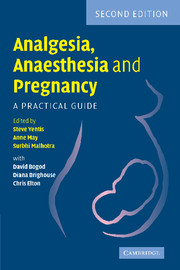SECTION 1 - PRECONCEPTION AND CONCEPTION
Published online by Cambridge University Press: 10 November 2010
Summary
ASSISTED CONCEPTION
There have been rapid developments in the treatment of infertility. The anaesthetist may be involved in many aspects of the patient's treatment, which may be complex. The harvesting of oocytes needs to take place within a defined period of time, or ovulation will have occurred and oocytes will be lost. Couples presenting for infertility treatment are generally anxious and often the women are emotional at the time of oocyte retrieval. It is therefore particularly important for the anaesthetist to understand the couple's anxieties and to be able to explain the effects of the anaesthetic technique that is to be used.
Problems/special considerations
All of the techniques involve extraction of oocytes from the follicles, either laparoscopically or, with the development of transvaginal ultrasonography, via the transvaginal route (ultrasound directed oocyte retrieval, UDOR). The techniques differ in the site of fertilisation and/or replacement of the gamete/zygote:
In vitro fertilisation (IVF): fertilisation occurs in the laboratory and the developing embryo is transferred into the uterus via the cervix, usually 48 hours after oocyte retrieval. Embryo transfer is performed with the patient awake, although there are occasions when the help of the anaesthetist may be required to provide sedation. The success rate is approximately 15–25%.
Gamete intrafallopian transfer (GIFT): the oocytes and sperm are placed together in the Fallopian tube, usually laparoscopically although an ultrasound-guided transvaginal procedure may also be used. The success rate is approximately 35%.
[…]
- Type
- Chapter
- Information
- Analgesia, Anaesthesia and PregnancyA Practical Guide, pp. 1 - 6Publisher: Cambridge University PressPrint publication year: 2007



